A New Landmark on the River of Life
By Hu Yifeng
[Indonesia] Abdul Haris Subarda
The Cimanuk River in West Java, a province lying 230 km east of Jakarta, capital of Indonesia, is regarded by the locals as the “river of life”. For hundreds of years, this river, meandering through mountains, nourished the surrounding land. But at times, it wreaks havoc as well.

During the rainy season, large swathes of land would be inundated by the rising waters of the river, while in the dry season, the downstream area would be afflicted by droughts. It was impossible to grow crops in the fertile downstream area since irrigation couldn’t be guaranteed due to the harsh natural conditions.
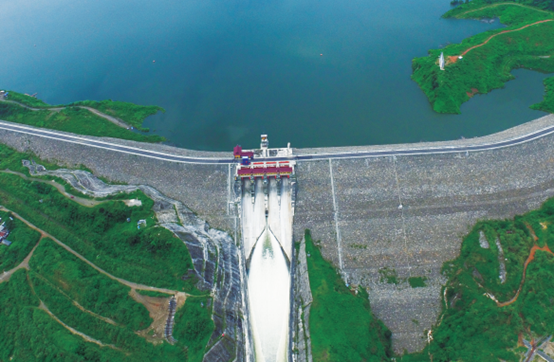
An aerial view of the Jatigede Dam
The Indonesian government planned to build a dam to provide water for irrigation. But though designed and reviewed by a couple of international companies since the 1960s, the dam could not be implemented for various reasons.
But in 2015, nearly half a century later, China's Sinohydro Corporation had built the Jatigede Dam with the joint efforts of the Chinese and Indonesians. The 110-m-high and 1,670-m-long dam was built as a public project in the interest of the local people.
Benefiting Both Farmland and Farmers
The dam has tamed the Cimanuk and the floods and droughts have become a thing of the past.
The 750-sq-m downstream area is now primed to withstand ferocious floods that are seen once in a century. The annual losses caused by floods are reduced by USD2.7 million, and the yield of paddy rice is increased by 310,000 tonnes and agricultural income by USD37.5 million each year.
The dam provides reliable and steady irrigation water for about 90,000 hectares of farmland, benefiting at least 4.8 million people downstream.
The Cimanuk River is flanked by farmland, which was the only but unstable source of living for the farmers. Due to floods and droughts farming used to be erratic in the past, but the dam has enabled local farmers to earn a good income.
Eudo comes from a farming family living 12 km downstream from the Jatigede Dam. With six members across three generations, this family owns only 6 mu of farmland, the mu being a Chinese land measurement unit equivalent to 666.5 sq m. They could hardly make enough money from farming to pay the daily expenses and the children's school fees. Farmers in the area could harvest rice only twice a year. The yearly yield was 450 kg in the rainy season and 220 kg at the most in the dry season. During the slack season, Eudo had to work as a migrant worker away from home to support his family.
In 2015, the reservoir of the Jatigede Dam was successfully impounded, significantly improving the local planting conditions. There would be no more troubling floods in the rainy season and in the dry season, there was a constant flow of water from the reservoir to ensure irrigation in the downstream area.
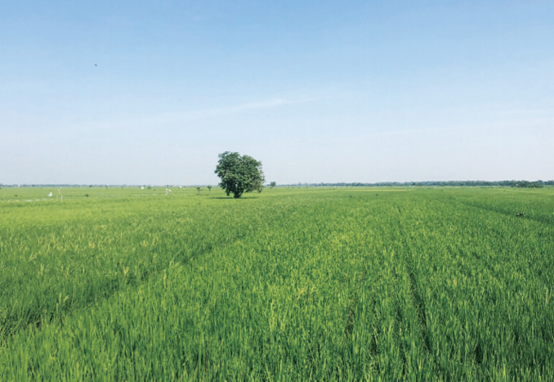
Farmland under irrigation in the downstream area of the Jatigede Dam
The rice yield used to be very low in the dry season, when the crop reaches the heading and flowering stages. The farmers tried to dig wells but it was of no use. Even the water supply for daily life was restricted and there was no water for irrigation. Now with the dam in place, even a long drought cannot affect the downstream farmland. There is a marked increase in rice yields and if the farmers plant in time, they can harvest rice three times a year.
For Eudo's family, it is a blessing, visible and tangible.
With fair harvests and an increased income, he can meet the daily household expenses without having to work part-time away from home. His family is comfortably off and together.
He and other villagers say that while the government initiated the plan to build a dam 50 years ago, their dream has finally come true with the help of the Chinese company that built the dam.
The Fast Track to Common Prosperity
The Jatigede Dam harnessed the Cimanuk to benefit the local people and put them on the fast track to common prosperity.
The construction of the dam created over 2,000 jobs locally for half the population of the surrounding 10 villages, and boosted their income significantly.
Sinohydro Corporation, the company that built the dam, trained the local staff in the technology and principles for operating the dam.“We employed local people so that they would not only make a living but also learn how to manage their own dam,” a construction manager said.
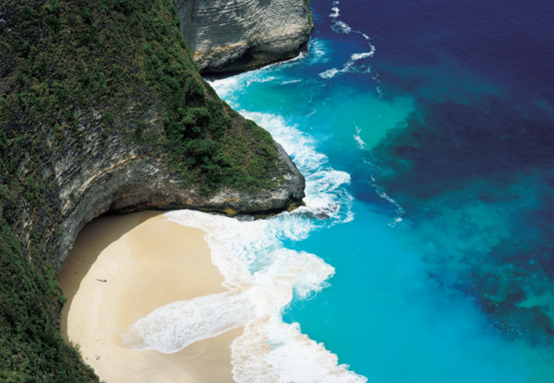
Kelingking Beach on the island of Nusa Penida
Asep, a local employee, has been working for the dam project for 10 years. He has become a very professional surveyor with rich experience, whose services are sought after by the local companies.
“My Chinese colleagues are very professional and hardworking, generously sharing their expertise with me,” he said. “I’ve learned so much from them. I hope I can continue to work here. ”
The dam overlooks a vast expanse of blue sparkling water surrounded by towering green mountains under an azure sky. It has become a landmark of West Java with its beautiful scenery, attracting droves of tourists.
The local government sponsored a pier and bought boats to run sightseeing tours, helping to boost the local tourism industry.
Many villagers work in the tourist zone. Some have opened shops and a few organize fairs in the reservoir area. The local traditional food and snacks are very popular at the fairs, particularly the coconut candy, which is often sold out of stock.
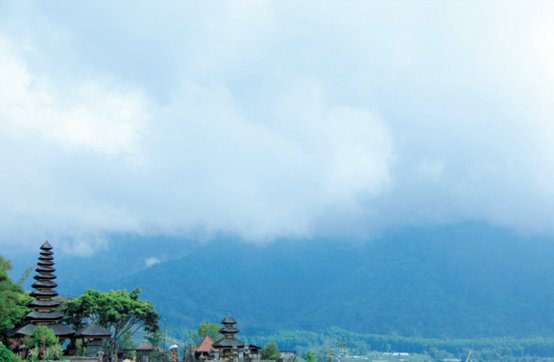
The Taman Ayun Temple in Bali, Indonesia
Ani is another local who has opened a restaurant in the reservoir area with her husband.
“My husband worked on the dam project. We opened this restaurant with the money he earned,” she said smilingly. “It's doing quite well, especially on the weekends with more tourists coming in.And I can look after my kid while running the business.”
Cijeungjing, a village one km from the dam, wore a despondent look five years ago with its rundown houses. When the dam broke ground, most of the villagers worked on the project as construction workers. It boosted their income and led to the sprucing up of their houses. The village today looks vitalized. The Jatigede Dam will ensure a stable supply of electricity, which will help to attract investment to develop the area with its own trade, agriculture, aquaculture and industrial zones as well as holiday resorts, creating a diversified development model.
Joint Efforts for Common Development
The dam, built with reinforced concrete, symbolizes the friendship, skills and joint efforts of China and Indonesia.
The team of Chinese and Indonesian workers drew on one another's strengths. The Chinese team studied and analyzed the available materials on the dam project and assessed the influence factors to produce a comprehensive review on the design of the dam.
Sinohydro teamed up with four Indonesian state-owned companies, WIKA, WASKITA, HK and PP, to form a loosely connected consortium on the project. As the joint project contractors, each is responsible for their own management and operation work. All of them deployed their personnel with the most technical and managerial expertise to ensure the smooth progress of the project by thrashing out problems through discussions.
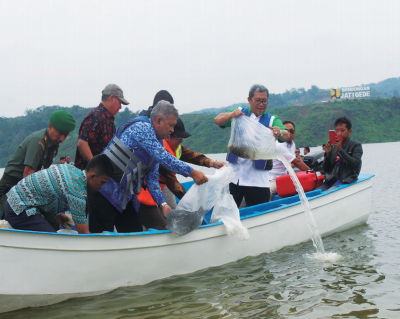
The reservoir is stocked with fishes.
The Cimanuk River Management Committee under Indonesia's Ministry of Public Works and Public Housing organized a young and capable project management team to oversee the construction site 7/24 and connect with office staff in real time to solve any ensuing problems in design and operation.
In June 2014, over 40 experts from the global NGO, the International Commission on Large Dams, visited the sites for the dam's irrigation tunnel, spillway and radial gates as well as the reservoir fill-ing area to learn about the work. After their briefing, they called the Jatigede Dam “the paragon of hydraulic projects in Indonesia”.
In the joint efforts to change life, the Chinese builders have bonded deeply with local people. They have helped them mend roads, repair wells, drains and schools and set fish fries in the reservoir.They are invited to local families for weddings, birthdays and other festivities.
Now with the Jatigede Dam, the new landmark in function, the people living along the Cimanuk River will no longer worry about hit of floods, droughts and poverty.
The Jatigede Dam will sustain the “river of life” and hold out the prospect of prosperity for more families.
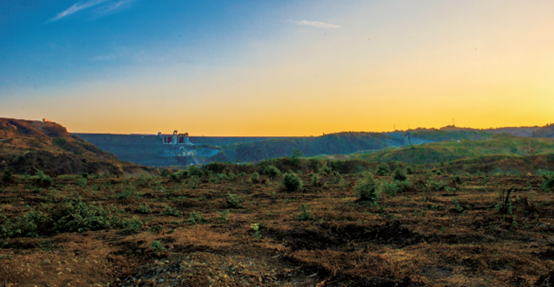
A distant view of the Jatigede Dam at dawn
FOR MORE
Project Overview
Jatigede Dam, contracted by China's Synohydro Corporation, officially began impounding its reservoir in August 2015. The reservoir's catchment area encompasses 1,460 sq km. The dam is 110 m high, and its crest elevation is 265 m. The minimum water level elevation is 230 m and the normal reservoir elevation 260 m. The dam will hold a reservoir with a 1.06 billion cu m storage capacity. It has carryover storage.
The 110 megawatt (MW) Jatigede hydropower plant is expected to become operational in 2020 with an annual generating capacity of 450 million kwh. If we calculate the current electricity price of the surrounding area as IDR800 per kilowatt-hour, the annual economic income it generates for Indonesia will stand at IDR360 billion or about USD40.45 million.


